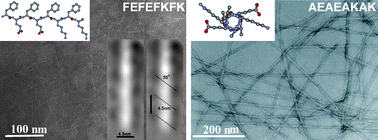Self-assembly and gelation properties of α-helix versus β-sheet forming peptides
Abstract
We have investigated the self-assembly and

- This article is part of the themed collection: Five years on
Maintenance work is planned for Wednesday 1st May 2024 from 9:00am to 11:00am (BST).
During this time, the performance of our website may be affected - searches may run slowly and some pages may be temporarily unavailable. If this happens, please try refreshing your web browser or try waiting two to three minutes before trying again.
We apologise for any inconvenience this might cause and thank you for your patience.
* Corresponding authors
a
School of Materials, The University of Manchester, Grosvenor Street, Manchester, UK
E-mail:
a.saiani@manchester.ac.uk
b School of Chemical Engineering and Analytical Sciences, The University of Manchester, Sackville Street, PO Box 88, Manchester, UK
c Jülich Centre for Neutron Science, Forschungszentrum Jülich GmbH, 85747 Garching, Germany
d Manchester Interdisciplinary Biocentre, The University of Manchester, 131 Princess Street, UK
e Faculty of Life Sciences, The University of Manchester, Oxford Road, Manchester, UK
f Tissue Injury and Repair Group, Faculty of Medical and Human Sciences, The University of Manchester, Oxford Road, Manchester, UK
We have investigated the self-assembly and

 Please wait while we load your content...
Something went wrong. Try again?
Please wait while we load your content...
Something went wrong. Try again?
A. Saiani, A. Mohammed, H. Frielinghaus, R. Collins, N. Hodson, C. M. Kielty, M. J. Sherratt and A. F. Miller, Soft Matter, 2009, 5, 193 DOI: 10.1039/B811288F
To request permission to reproduce material from this article, please go to the Copyright Clearance Center request page.
If you are an author contributing to an RSC publication, you do not need to request permission provided correct acknowledgement is given.
If you are the author of this article, you do not need to request permission to reproduce figures and diagrams provided correct acknowledgement is given. If you want to reproduce the whole article in a third-party publication (excluding your thesis/dissertation for which permission is not required) please go to the Copyright Clearance Center request page.
Read more about how to correctly acknowledge RSC content.
 Fetching data from CrossRef.
Fetching data from CrossRef.
This may take some time to load.
Loading related content
